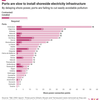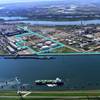At 303.9 million tons, cargo throughput in the port of Rotterdam in 1999 fell by 3.5 percent. This decrease is less than the 3.7 percent in the first half-year, but is a downturn compared with the top year of 1998 when 314.8 million tons were handled. The volumes of container cargo, grain and animal feed, scrap metal, and other liquid bulk cargo increased considerably this year.
However, this did not compensate for the decrease in imports of ore, or the throughput of crude oil and coal. The tonnage of other general cargo (pallets, bags, boxes, big bags) also underwent a further decline, with the exception of fruit and vegetables.
The Mayor of Rotterdam, Ivo Opstelten, and Chairman of the Board of the Rotterdam Municipal Port Management (RMPM), Willem Scholten, pointed out that, despite the decline in tons, at $7 billion the direct added value of the port and industrial complex has remained at the level of 1998 and is expected to increase in 2000 to $7.4 billion. In addition, more than 100 hectares of port sites (net) were issued in 1999.
"Rotterdam's port activities are a consequence of world trade flows, among other things. For example, particularly in relation to ore imports, you can still see the after-effects of the Asia crisis of 1998. The increase in world trade anticipated by the WTO and OECD will certainly have a favorable impact on activities in the Rotterdam port and industrial complex. But that can be due to all kinds of factors, such as added value, employment, the number of visiting ships or throughput," said Scholten.
General Cargo
Calculated on the basis of the number of teu, container throughput increased this year from 6 to 6.4 million units. In weight the volume of container cargo increased more, by 8.2 percent to 66.7 million tons. Exports increased by 9.7 percent. Both are clear signs of the economic recovery in Asia. During the last quarter, moreover, the extra imports into Rotterdam also stood out.
A small millennium sprint: many shippers wanted to have their goods delivered before the end of the year. RoRo traffic increased slightly in comparison with 1998 by 1.5 percent to 10.3 million tons. On the most important routes to and from the United Kingdom, market ratios between the Channel Tunnel and the ferries have stabilized in the past two years, and the freight tariffs have increased slightly again. RoRo traffic is expected to increase further in the coming years. Both P&O North Sea Ferries and Stena Line have ordered new, faster ships.
With the exception of fruit and vegetables, other general cargo decreased considerably to 8.2 million tons. As a result of the low rates in the container liner trade, extra freight was attracted, which was traditionally transported as conventional general cargo or neo-bulk. All the large West European ports are experiencing this trend: in Antwerp - Europe's largest conventional general cargo port - this sector fell by more than 20 percent; in Hamburg the degree of containerization is already some 90 percent.
Dry Bulk Cargo
At 33.5 million tons, ore imports have never been so low during this decade. In the first half-year, there was a decline of more than 28 percent. The European steel industry is still affected by an influx of cheap steel products from Russia, South America and South East Asia. Many national currencies in this steel exporting region have been devalued during the past two years. As a result of this, Europe became a steel import region for the first time in 1998.
The export of scrap metal rose by 10.9 percent to 3.7 million tons. A result of increasing demand is new participant Newco, which started for the first time this year in the scrap metal terminal in the Botlek area. In the field of agri-bulk there were a number of new initiatives (including floating cranes, board-board transfer), while a few cargo packages were also "won back." As a result of this, and as a result of the low prices of overseas animal feed raw materials such as tapioca, throughput of grain and animal feed increased for the first time in six years by 9.8 percent to 12.5 million tons.
Trends on coal throughput showed an increase up until June. After this a steep decline took place. Over the year as a whole, 18.0 million tons were handled, a decrease of 19.9 percent in comparison with 1998. More factors lie at the root of this, including lower consumption by Dutch power stations, less transit via Rotterdam to England, which imported more directly and competition from other ports.
In addition, a relatively high volume of imported coal for Germany was supplied by rail from Poland and the Czech Republic. The amount of other dry bulk cargo (including sand, cement, phosphates) was also lower at 11.5 million tons. In particular, fewer raw materials for the steel and artificial fertilizer industry were imported.
Liquid Bulk Cargo
At 95.4 million tons, crude oil throughput remained 5.3 percent below the level of last year. Since storage tanks were filled to bursting at the end of 1998, the oil companies profited from the considerable price increase under the influence of the production limitation of the OPEC countries.
Nevertheless, stocks in Rotterdam are hardly any lower than a year ago. However, the origin of crude oil has changed considerably during the past decade. In 1990 approximately 10 million tons of North Sea oil from Norway were discharged. At almost 24 million tons, that country is now the most important oil supplier.
The volume of petroleum products handled was almost at the same level as last year. Fluctuations in imports and exports result from regional differences between the demand for specific petroleum products and regional refining capacity. Since the capacity has increased worldwide, throughput in Rotterdam has structurally declined: from more than 30 million tons at the beginning of the eighties to 19.4 million tons in 1999.
There is a reverse trend in other liquid bulk cargo, especially bulk chemicals. At the beginning of the eighties, some 10 million tons were handled in Rotterdam, this year 24.7 million tons. This means that the chemical industry has an increasingly important place in the port and industrial area and is producing substantial quantities. The poor first quarter of this year appears to be completely forgotten. Furthermore, considerable investment is again being made.
Sponsored Content
Safer Starts Here: Build Ships, Protect Crews

July 2025
 Read the Magazine
Read the Magazine

 Read the Magazine
Read the Magazine
This issue sponsored by:

Schottel Mark’s 75th Anniversary of the RudderPropeller
Subscribe for
Maritime Reporter E-News
Maritime Reporter E-News is the maritime industry's largest circulation and most authoritative ENews Service, delivered to your Email five times per week









